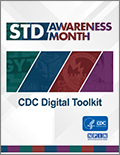Customizable Article - #GYT
The pre-written article below can be adapted and used by health departments, community-based organizations, journalists, bloggers, media, or others looking to spread the word about STD prevention to groups such as your partners, local decision makers, or the general public.
How can I use this article? The article can be shared on listservs, online, in newspapers, magazines, blogs, or newsletters. It is customizable – you can use data from your state or county to make it more meaningful to the people in your community.* You can customize this article further by adding an optional quote from someone, such as a spokesperson, health official, or a member of your organization’s leadership. A placeholder in the text indicates where a quote could be inserted.
Where can I find STD data to customize the article? Reported data for chlamydia, gonorrhea, and syphilis can be accessed by contacting your state or local health department, browsing CDC’s STD Surveillance Report tables, or using CDC’s AtlasPlus (a tool that allows you to access state and county level data for these and other reportable diseases). If you need national data to fit your needs, please refer to the STD Surveillance Report tables or national “State of STDs” infographicCdc-pdf
*CDC includes cases of primary and secondary (P&S) syphilis when referenced within these articles. P&S syphilis are the most infectious stages of the disease and therefore are helpful for understanding syphilis trends across the country. Using local P&S syphilis data is encouraged for the fairest comparison with what is happening nationally.
The customizable article begins below. Note: there is a sidebar available below the article.
Young People Hard-Hit by STDs: Know the Facts, Get Yourself Tested
Three common STDs—chlamydia, gonorrhea, and syphilis—are surging across the United States, according to the Centers for Disease Control and Prevention (CDC). Young people are especially hard-hit. In fact, because reported cases only account for a fraction of the national burden, CDC estimates 15-24-year olds account for half of all new sexually transmitted infections each year. <insert jurisdiction> is no exception. In 20XX alone, there were XX reported cases of chlamydia, XX reported cases of gonorrhea, and XX reported cases of syphilis among this same age group.
“The consequences of STDs are especially severe for young people,” said Gail Bolan, M.D., director of CDC’s Division of STD Prevention. “Because chlamydia and gonorrhea often have no symptoms, many infections go undiagnosed and this can lead to lifelong repercussions for a woman’s reproductive health, including pelvic inflammatory disease and infertility.”
Untreated STDs can also increase a person’s risk of getting HIV, or passing it to a partner if they’re living with HIV.
Early detection through testing is key to avoiding these consequences, yet research has shown many adolescents don’t talk with their providers about sexual health issues at all during annual health visits.
GYT: Get Yourself Tested
Enter GYT: Get Yourself Tested – a youth-focused campaign that encourages STD testing.
GYT helps young people understand that STD testing is quick, simple, and usually painless. It also underscores the importance of having open and honest conversations with their healthcare provider about their sexual history to ensure they get the right STD tests and other critical information about prevention.
Those who are not comfortable talking with their regular healthcare provider about STDs can access CDC’s online testing locator to find a convenient testing site that is free or low cost.
[“Insert OPTIONAL Quote from health official, spokesperson, or other organizational leadership,” said [enter name, title, organization. “Insert second part of quote as indicated/appropriate.”]
Getting tested for STDs is one of the most important things a person can do to protect their health, but it’s not the only thing. There are several ways to prevent STDs. The most reliable way is to not have sex (vaginal, oral, or anal), but there are many other tried-and-true options: talking openly with partnersExternal
Visit the GYT: Get Yourself Tested campaign website for more information on STD testing and prevention.
Know the Facts:
- You can’t tell someone has an STD just by looking at them.
- STDs often have no symptoms. The only way to know for sure if you have an STD is to get tested.
- STD tests aren’t always a part of a regular doctor visit—you may have to ask for tests.
- Almost all STDs that can be spread via unprotected vaginal sex can also be spread through unprotected oral and anal sex.
- Birth control methods like the pill, patch, ring, and IUD are very effective at preventing pregnancy; condoms protect against pregnancy and STDs.
- STD testing is a basic part of staying healthy.
